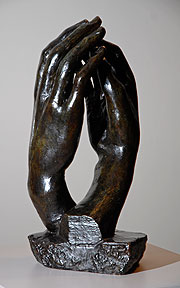  |
| HOME | THIS ISSUE | CALENDAR | GRANTS | BACK ISSUES | < BACK | NEXT > |
Benton Museum hosts exhibition of works by Auguste Rodinby Sherry Fisher - September 17, 2007 | ||||
| A kiss is just a kiss – unless you are looking at Auguste Rodin’s celebrated sculpture. “The Kiss” is one of 68 of the artist’s bronzes in the exhibition Rodin: A Magnificent Obsession, Sculpture from the Iris and B. Gerald Cantor Foundation at the William Benton Museum of Art. The show runs through Dec. 16. The exhibition includes sculptures ranging from monumental to small scale models, works on paper, photographs, and other documents. Wall murals and panels explore Rodin’s life and the process of sculpture, and provide other information. A video produced by the Cantor Foundation describes the process of creation of the artworks. “Rodin was the greatest sculptor of his time,” says Steven Kern, director of the Benton museum. “We’re excited to have his work here.” The exhibit was organized and made possible by the Iris and B Gerald Cantor Foundation. Admission is $5. “The exhibition is not just for those in art and art history – it’s also for people in the humanities and sciences,” Kern says. “I think this exhibit opens up a conversation, not only about artistic inspiration, but about bronze, metals, and casting. We can talk about both the technical and the aesthetic side of Rodin’s work.” David Woods, dean of the School of Fine Arts, says the exhibit “opens new perspectives of art for students, faculty, and members of the community. It raises the artistic standards of the Benton Museum to even higher levels.” Rodin was born in 1840 and died in 1917. Like many artists, he struggled for recognition throughout his early career. “He prevailed over negative criticism and persevered until his work finally reached acceptance,” Kern says. Sculpture became a large-scale enterprise during the later part of the 19th century. An expanding middle class, growing cities, and the Industrial Revolution created a strong demand for multiple casts of popular sculpture. Both the avant-garde and the bourgeoisie admired Rodin and demanded his art. “His work entered into popular culture in his own time,” Kern says.
“The market for his sculpture was huge, and he met the demands by casting reductions and enlargements of his work.” Rodin believed that being true to nature was the source of beauty. He refused to idealize his models: Instead, he emphasized every contour of the human body. He was one of the first artists to maintain that a part of a figure, such as a hand or torso, could stand alone as a complete work of art. He found inspiration and new creative energy in the power and formal beauty he saw in fragments. During the time in which Rodin created his sculptural masterpieces, the visual arts in France were varied, innovative, and revolutionary. As a complement to the sculptures by Rodin, the Benton’s curator selected 15 works from the Benton’s permanent collection by artists of the same period. These include works by Theodore Ribot, Alphonse Legros, and Camille Pissarro. Rodin’s Contemporaries is on exhibit in the Benton’s balcony gallery. Some of the works in the main exhibition were cast during Rodin’s lifetime, while others were cast after he died, according to his explicit wishes and instructions to the French government, responsible for the administration of his estate. The history of each sculpture is described on labels and further explained in other text and the video, says Kern, noting that there has been some controversy regarding the authenticity and originality of the sculptures. “These issues are fodder for discussion,” Kern says. “The exhibition offers an opportunity to understand the historical and continued casting of Rodin’s bronzes reflecting the artist’s instructions and embracing his wishes in accordance with French and international law.” There will be noontime gallery talks about Rodin and his work on Oct. 2, Oct. 16, Dec. 4, and Dec. 11. The museum is open Tuesday through Friday, from 10 a.m. to 4:30 p.m., and Saturday and Sunday, from 1 p.m. to 4:30 p.m. |
| ADVANCE HOME UCONN HOME |

